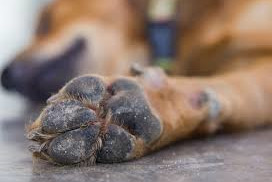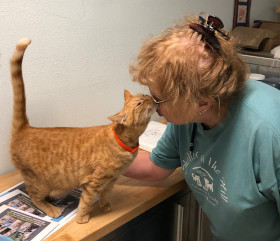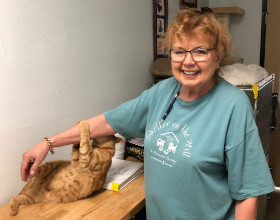Most pet owners have not only heard of distemper but also know that it's high mortality rate makes it especially dangerous. Until last week I never realized that canine distemper can also infect a wide range of wild carnivores, most commonly foxes, raccoons and skunks - all of which live in my rural area of California.
Last week the Department of Fish & Wildlife reported an unusually high number of canine distemper virus (CDV) cases in wildlife populations throughout the entire state of California.
The report warns that unvaccinated domestic dogs can potentially contract the disease through contact with food bowls and water sources that are "shared" with infected wild carnivores.
In the report Senior Wildlife Veterinarian Deana Clifford says that distemper is the most common disease cause-o-death in California's carnivores. Transmission of the distemper virus typically occurs similar to the common cold, via inhalation of infected respiratory droplets or direct contact with saliva, nasal discharge and tears.
As in domestic canines there is no treatment for sick animals except supportive care. Infected animals may or may not survive the illness. Signs include (but are not limited to) depression, fever, labored breathing, diarrhea, anorexia, incoordination, moving in small circles, yellow to clear discharge from the nose and eyes, and crusting on the nose, eyes, mouth or footpads. Animals with the virus may not show clinical signs but can still spread the virus for up to 90 days.
In addition to removing food and water dishes, the department of Fish & Wildlife urges the public to keep both themselves and their pets a safe distance from sick or injured wild animals, as animals that are ill or feel threatened may act aggressively.
One hot summer day in Chicago in the 1940s when I was just a wee lass we fried an egg on the sidewalk in front of 5419 Fairfield Avenue in Chicago. Thirty years later in the midst Time Magazine's dire predictions of the "New Ice Age" and that we would all be dead in our beds of frostbite by Y2K, my neighbor's children did a summer science experiment and fried an egg on the sidewalk at 1042 Windsor street in San Jose. The summer after we survived the supposed collapse of computers worldwide unable to make the transition from 1999 to 2000, we celebrated by frying an egg on my patio in Sunnyvale. And now it's 20 years later and summers haven't changed - they still get hot enough to fry an egg on the sidewalk - and also to fry your dog's paws.


The problem is the asphalt temperature and the outdoor temperature are two very different things. When the air temperature is 77 degrees asphalt in the sun is 125 degrees. When the air temperature is 86 degrees the asphalt temperature is 135 degrees. Since you can fry an egg at 131 degrees just imagine how your dog feels as you drag him along to the farmers market or an outdoor festival being held on asphalt.
Fortunately there's a couple of easy ways to tell if the pavement is too hot for your pups bare paws - the most direct way is walking on it in your own bare feet. Dogs paw skin is not any thicker than the skin on your own feet. Or you can place the back of your hand against the pavement and hold it there for 7-10 seconds. if it's too uncomfortable for you to leave your skin there, then you shouldn't make your dog do it.
Also, think about the time of day. It takes hours for the pavement to cool off after the outdoor temperature goes down. Asphalt soaks up the heat all day and can only cool down after sunset so pavement that was deemed safe for a walk at 9 am may still be too hot in late afternoon. Much better to head to your outdoor event in the morning when the pavement is cool.
As a basic "rule of paw" - if the surface is too uncomfortable for your own bare hands or feet for at least 7-8 seconds then could seriously injure your dog's paws.
And always remember if you want to take an outing with your dog in the summer think water! It's good for drinking and it's also good for cooling hot tootsies, both yours and your dogs!
Candace Huskey, President

Sitting around a large table, in Mountain Aire Veterinarian Hospital, with Dr. Diane, Mr. and Mrs. Brimble, Candace and others, seemed to me to be a great place to begin to bring reality to the dream of building an Animal Shelter for lost and abandoned animals. The year was 1999.
Fast forward to the completion of Shelter On The Hill: A Humane Society, although officially not open, and the "dropping off" of nine large breed, five week old puppies, the need for this facility was written in concrete. That very concrete the Shelter was built on.
I have owned and been owned by, cats and kittens since I was a child. My Mom was very good about allowing me to keep the felines that "followed me home". She also made me responsible for their welfare. That fact alone kept the number to a minimum.

Volunteering in the SOTH Cattery is a never ending source of learning, experience, laughter and being close with other feline enthusiast. And, all of the dedicated Volunteers, in my opinion, set compassion for animals up to a new level.
From the beginning, my husband, Horst, worked by my side doing whatever needed to be done. Anything from computer mailing lists for our fledging Newsletter to putting up and taking down tents at events to taking pictures of our annual Wine and Cheese fundraiser and much more. He would set up little forts in our living room for kittens needing socialization. Then watch our Uncle Fritz black cat, as he worked with the kittens. (Fritz was an alumni of SOTH).
We currently have three cats and one dog, all rescues.






